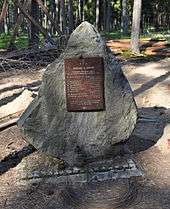Puszcza Darżlubska
Puszcza Darżlubska (pronounced [puʂ'tʂa darʐlubska]) or Lasy Piaśnickie (English: Darżlubska Wilderness or Darżlubie / Piaśnica Forest) located in northernmost part of Poland, is a Polish forests complex on the Baltic Sea, within the geographical region of Pobrzeże Kaszubskie;[1] on the south-side bordering the Tricity Landscape Park (Trójmiejski Park Krajobrazowy) from which it is separated by the Reda river. Inside Darżlubie Forest there are two nature reserves (Polish protected areas). The wilderness is also the source of two rivers: Piaśnica and Gizdepka. The name of Puszcza Darżlubska comes from the nearby village of Darżlubie in the administrative district of Gmina Puck, north of Gdańsk.[2]
Puszcza Darżlubska is a place of Polish and Jewish martyrology; the second largest site of mass killings of Polish civilians in Pomerania (after Stutthof) during World War II.[3][4] The waves of Nazi German executions, known as the Mass murders in Piaśnica, of about 12,000–16,000 hostages (mostly intelligentsia), were committed between the fall of 1939 and spring of 1940 near the town of Wielka Piaśnica.[4][5]
With the total area of c.17,271 ha Puszcza Darżlubska includes two protected landscape areas called Darżlubskie Buki and Źródliska Czarnej Wody Nature Reserve. The flora of both is similar to that of the Tricity Landscape Park established in 1979. The dominant tree is European Beech (Fagus sylvatica) forming thickets with pine and other coniferous trees.[2]


Two among 30 identified mass graves hidden in the woods, from the Nazi German Intelligenzaktion Pommern against civilian Poles living in Pomerania [6]
Geography
The area is covered mainly by coniferous forest in which the dominating tree is beech forming lowland groves. The beech is relatively young in the region. After the retreating glacier and the gradual warming of the climate around c.8,000 BC, the whole area was first covered by tundra. Along with the rise of temperature, the flora of the tundra gave way to new forest ecosystems in which most prominent were birches (Betula), pines (Pinus) and hazel (Corylus). The ecosystem of the primeval forest changed again with additional, warmer (stenothermic) varieties entering the landscape, including aspen (Populus tremula), elm tree (Ulmus), oak (Quercus) and ash tree (Fraxinus).[2]
In spite of scarcity of tourist trails, Puszcza Darżlubska, is also a good recreational area with many natural, historical and cultural artifacts and various points of interest for the visitors.[2]

The killing ground
Soon before the 1939 Nazi Invasion of Poland, German police and Gestapo prepared a special lists of Poles and Jews who were to be executed first. The 192-page-publication, called the Special Prosecution Book-Poland, identified more than 61,000 Polish targets by name, including Polish priests, teachers, doctors, dentists, veterinarians, military officers, prominent businessmen and merchants. After the invasion, as part of their preplanned Intelligenzaktion in Pomerania,[7] the Nazis executed around 65,000 Polish citizens in the region women and children alike, before the end of spring of 1940. One of the main sites of systematic large scale murders was the Puszcza Darżlubska forest.[6] An organized action to destroy evidence of the massacres was undertaken by Nazi authorities in the second half of 1944.[7][8][9]
See also
Notes and references
- ↑ Elżbieta Grot (2009-02-10). "Ludobójstwo w Piaśnicy z uwzględnieniem losów mieszkańców powiatu wejherowskiego". Biblioteka Publiczna Gminy Wejherowo. Retrieved May 17, 2011. (in Polish)
- 1 2 3 4 Ryś, M. (2010), Puszcza Darżlubska: "Krótka charakterystyka środowiska przyrodniczego na terenie Komunalnego Związku Gmin "Dolina Redy i Chylonki" (in Polish), Gdynia: Komunalny Zwiazek Gmin, retrieved 23 December 2010
- ↑ Premier RP na obchodach rocznicowych w Piaśnicy, Wejherowo: BIP, Urząd Miejski w Wejherowie, 2010, retrieved 24 December 2010 see also: "Polish Prime Minister at the anniversary celebrations in Piaśnica", (paragraph 2, line 2) by Google translate
- 1 2 Popławski, Grzegorz (2010), "Piaśnica - pomorski "Katyń" (Piaśnica - Pomeranian Katyn) (in Polish), Gdynia: Dziennik Baltycki (The Baltic Daily), retrieved 23 December 2010
- ↑ Cherry, Robert D.; Orla-Bukowska, Annamaria (2007), Rethinking Poles and Jews: troubled past, brighter future, Lanham MD: Rowman & Littlefield, p. 100, ISBN 0-7425-4666-7, retrieved 23 December 2010
- 1 2 Batory, Marcin (2010), Site of Nazi mass executions in Piasnica, Tübingen, Germany: Sites of Memory, retrieved 25 December 2010
- 1 2 Moor-Jankowski, Jan (2010), Holocaust of Non-Jewish Poles During WWII, Washington Metropolitan Area Division: Polish American Congress, retrieved 23 December 2010
- ↑ Lukowski, Jerzy; Zawadzki, Hubert (2001), A concise history of Poland, Cambridge University Press: Cambridge concise histories, Concise Histories Series, p. 228, retrieved 23 December 2010
- ↑ Grot, Elżbieta (2010), "Ludobójstwo w Piaśnicy z uwzględnieniem losów mieszkańców powiatu wejherowskiego." (Genocide in Piaśnica with a discussion of the fate of the inhabitants of Wejherow county" (in Polish), Wejherowo: Public Library of Wejherowo, retrieved 23 December 2010
Coordinates: 54°39′57″N 18°16′15″E / 54.665919°N 18.270931°E